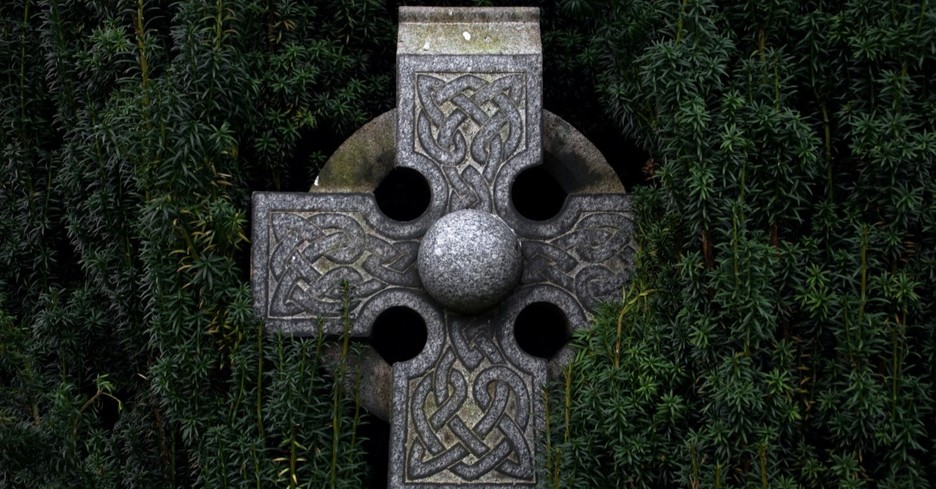
We owe a great deal of our cultural and spiritual heritage to men whose names most people no longer remember or recognize.
Out of Ireland they came, bearing Celtic names and breathing holy power. Missionaries swarmed out of Ireland a long, long time ago in the sixth, seventh and eighth centuries: Gall, Columba, Ferghil, Aidan and thousands more, whose names are no longer remembered. Driven by missionary zeal, they came east, reintroducing and reviving the learning that had perished wherever the barbarians had gnawed the bones of the Roman Europe.
Europe was enriched by their influence. We live and breathe their heritage but scarcely know their names, much less their achievements. "The monks of the age of Saints went their way more than a thousand years ago, and infidelity, cynicism and evil have not entirely eroded the good that they achieved," says historian William H. Marnell. The Irish built monasteries, sent out missionaries, converted the heathen, and uplifted and improved the life of the average person. Wherever they went, Irish missionaries brought a Celtic spirit: haunting Irish hymns, delight in natural beauty, a craving for seclusion, and love of adventure.
They went out in groups of twelve, imitating the Apostles. At times, other Christians had gone before them. However, after centuries of barbarian attacks and Arian influence, the church, even in Italy, was in a sorry state. The Celtic missionaries pushed through Europe's wilderness of forest and swamp and savage tribes. They were the David Livingstones of their day, but even more successful. From the great monasteries of Iona, Lindisfarne, Luxeuil and Peronne sprang others. Their locations were often inaccessible, but through them, Europe became more civilized. Wild and lonely sites cleared by the monks eventually became great cities. The cities of Bobbio, Wurzburg, Fontenelle, Salzburg and others exist because the Irish planted monasteries there. Faithful Irish missionaries converted a continent in the longest sustained missionary drive of history.
History records that this missionary movement began with Columba (c. 521-597). Legend says that he preached the Gospel to the Picts of Scotland in an attempt to atone for killing a host of rivals. We cannot establish this as fact, but we can say that Columba founded a monastery on Iona off the coast of Scotland. His zeal and holiness, along with the purity and love of his fellow workers, made a great impression on the heathen. Half a dozen new monasteries emerged from Iona, each staffed by Irishmen and Picts who longed to be part of the Kingdom of God.
It is difficult for most modern Protestants to understand the concept of the medieval monastery. However, if we think of the Irish monasteries as mission compounds, and the monks as missionaries who renounced marriage in order to carry the Gospel without family encumbrances, we begin to see them in a new light. These early monks were not loafers. They were hard-working, rigorously disciplined, zealous to reach souls for God's Kingdom, ready to confront any danger, and happy to lay down their lives in martyrdom. They truly suffered for Christ. Wherever they went, the common folk flocked to them, resulting in an inevitable loss of solitude.
Conversions in the Thousands
From Iona, the Irish influence spread to northern England. Aidan founded a monastery at Lindisfarne, and he and his followers repeated the success story of Columba. An exiled prince by the name of Oswald became a Christian. As ruler of Northumbria, he labored strenuously to bring his nation to Christ, and acted as interpreter for Aidan. Thousands were converted, whether sincerely or otherwise, and new monasteries sprang up. These monasteries, in turn, produced such great scholars as Alcuin and Bede and sent out the great missionary Boniface and a host of other Saxon soul winners. After ruling for eight short years, Oswald died in an attempt to stave off a pagan invasion. However, the church did not die. Instead, it spread wherever the Angles, Saxons and Jutes had settled.
All the same, southern England yielded slowly. Kent was Christianized by the Italian monk Augustine (died between 604 and 609), the personal envoy of Gregory the Great. However, he made little headway in the rest of England and none at all in Wales, where he was viewed as haughty. By contrast, the Irish had a knack for warming hearts and winning men into the kingdom rather than imposing religion upon them. Gradually they won Wessex, Essex, Mercia, Sussex and even the stubborn kingdoms of Wales to Christ.
Even before England's conversion was complete, the conversion of mainland Europe began. Columbanus left Ireland for France with the requisite twelve companions. From the monastery they established at Luxeuil, they exerted an elevating effect on the Gaulish church, which had grown apathetic and political. More Irish came and monastery after monastery sprang up, glowing with fervor, lighting their torches at the flame of Luxeuil and spreading across the ancient Roman regions of Europe. Nearly seventy monasteries showed the barbarians by practical example what a few dedicated men could do. The monks cultivated uncultivated soil, drained dismal swamps, prayed, taught, and copied books. Men with hungry souls came, saw, and returned home with new hope. Kings also were converted, and whole populations dutifully turned to Christ, although they had no real knowledge of what such a conversion meant. The monks bravely schooled them en masse for a few days, baptized them, and hoped for the best. However, in many cases, the new converts suffered from the lack of a knowledgeable shepherd.
Columbanus stepped on the royal toes with his denunciations of sin and was sent packing from Luxeuil. He moved on, founding another monastery in Gaul and a third among the Lombards in Italy. His companion, Gall, ventured into Switzerland and reinvigorated the stagnating church there. At Peronne in Belgium, other Irishmen settled, bringing the Gospel to the lowlands. Peronne became known as "Peronne of the Irish." Still others went to Germany, but the German monasteries did not have the impact of Luxeuil in Gaul or Sankt Gallen in Switzerland. It was an Englishman, Wilifred (c. 675-754), better known to history as St. Boniface, who converted the Germans. Another Englishman, Willibrord, and a Frank, Amand, brought the northern parts of the lowlands (modern Belgium and Holland) to Christ.
When a fire has burnt low, wood undercut by burning will often drop down and send up sparks and renewed flame. In the same way, the Irish, after their day was passed, flickered once more into flame and sent missionaries after the year 1,000 as far east as Kiev in Russia and as far west as Iceland.
The Irish role in world history must not be minimized. Some say they saved civilization. If this is the case, then civilization was saved in the name of Christ.
Facts about the Celtic Missionaries
- Columba was humble. "He would bathe the feet of the Brethren after their daily labor, he would carry the bags of flour from the mill to the kitchen..." He also was "most strict and constant in fasting, in prayer, in meditation."
- Vigilius (Ferghil, c. 700-784), apostle to Salzburg, held that the world was round and people lived on the other side. Boniface wrote to Rome, asking that Vigilius be disciplined for his "error."
- Aidan (d. 651) had a deep concern for the poor and he ransomed slaves, some of whom he trained to be priests.
- Irish missionaries were called peregrini, wanderers, because they wandered for Christ. They did not always give stable leadership to the churches they created, for they tended to wander on to new fields.
- While Irish zeal eventually waned, the monasteries still produced beautifully illustrated manuscripts such as the Book of Kells.
- Fursa, an Irish visionary, set out to evangelize Belgium at the appeal of Pepin's wife. He died on the way, but his work was continued by his brothers, who founded Peronne.
- The Irish brought to Europe a lovely script and many writings which helped foster the Carolignian renaissance. A British monk, Alcuin (c. 740-804), redesigned the Irish script into the even more beautiful Carolignian Minuscule.
- Gall (c. 550 - c. 650) was so zealous against pagan idolatry that he set fire to shrines and threw pagan offerings into Lake Zurich.
- Gall's influence was augmented by of his gift of languages. He preached to the Alamanni in their own tongue.
- The Irish celebrated Easter at a different time than Rome, and their monks cut their hair differently. Irish abbots oversaw bishops, whereas Rome's bishops oversaw abbots. Conflict between the two traditions was inevitable. The synod of Whitby in 664 determined England would accept the Roman Easter.
- An Irish monk named Kilian (d. c. 689), brought the Gospel to Wurzburg in Germany, but died when he denounced a king's irregular marriage. The irate wife successfully plotted his assassination.
Bibliography:
1. Cahill, Thomas. How the Irish Saved Civilization. New York: Doubleday, 1995.
2. Latourette, Kenneth Scott. A History of the Expansion of Christianity: The Thousand Years of Uncertainty. Grand Rapids: Zondervan, 1970.
3. Marnell, William H. Light from the West; the Irish Mission and the Emergence of Modern Europe. New York: Seabury Press, 1978.
4. Robinson, Charles Henry. The Conversion of Europe. New York: Longman's, 1917.
Further Reading:
Death of Ireland's St. Colman Ela
Patrick: Making of a Missionary
Ireland's Author-Evangelist Adamnan
Who Was St. Brigid of Ireland?
Patrick: From Slave to Missionary
Photo Credit: Adrian Moran/Unsplash
(Article first published on Christianity.com on June 11, 2010)


